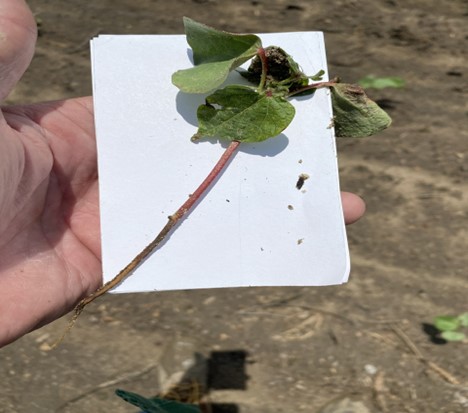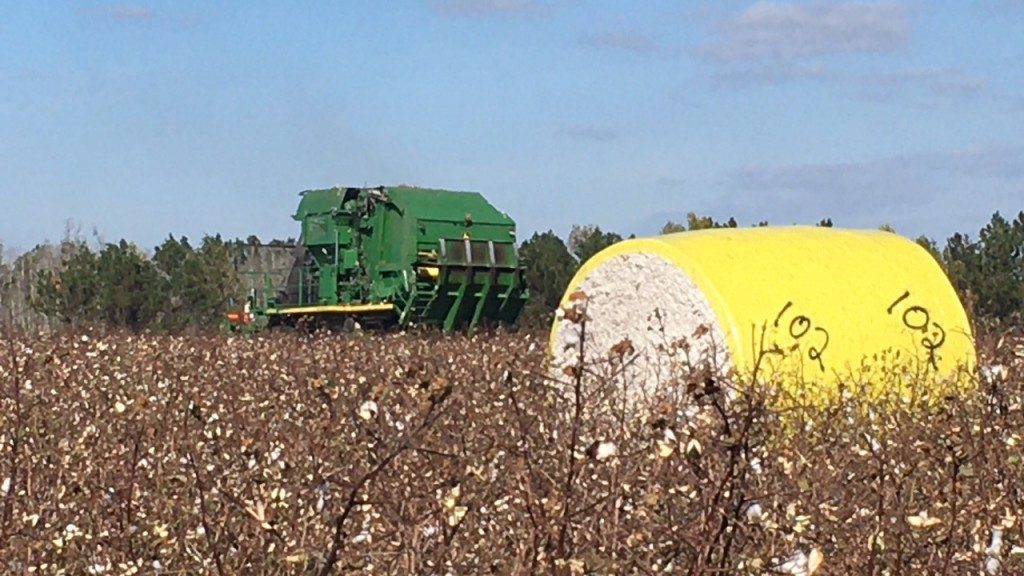Be sure to check out the latest UGA Peanut and Cotton Team Podcast Episodes below:
Below is a link to the fifth episode of the Talkin’ Cotton Podcast, which is largely a discussion on our current situation revolving around wetter weather. Thoughts on insect and weed management, being good stewards of agrochemicals and technology, planter mishaps, and considerations moving forward. Feel free to share far and wide. It will be posted on the UGA Cotton Team website Monday. Remember, the link below will take you to buzzsprout, but the podcast is also posted on Apple Podcasts, Spotify, and Amazon Music.
Episode 5 – https://www.buzzsprout.com/2350262/15083609
EPISODE 12, Season 2
In this episode, Dr. Scott Monfort talked peanuts with Dr. Glen Harris, Dr. Scott Tubbs, Dr. Bob Kemerait, and Dr. Wes Porter. In this episode, the peanut team talks about what is currently happening in the field for the 3rd week of May.
Current situation: The rainfall estimates from the last seven days are below. Wet conditions have hindered the planting effort. Cotton crop ranges from trying to emerge to 5th leaf stage. Early planted corn is approaching VT.

I received the following graphic from Dr. Eric Prostko, which compares the rainfall from April 15, 2024, to May 18, 2024, and the average of the same dates from 1981 to 2010. This data comes from various locations of the UGA Weather Network. The Sunbelt Expo location received over 13 inches of rain compared to the average of almost 2.5 inches. Valor injury has been another topic of concern for local growers. We discussed this topic last week.

The crop progress from Georgia Crop Progress and Condition Report, released on May 20, 2024. This report and all National Agricultural Statistics Service reports are available on the NASS website.

Do I need to replant my peanuts? The weather over the last few weeks has been challenging for local peanut growers. I have received a call or two about evaluating peanut stands. According to Drs. Scott Monfort and Scott Tubbs, UGA Peanut Agronomists, we are looking for a final plant stand of at least 4 plants per foot of row to maximize yield and to minimize TSWV infection. This does not mean a grower with 2.5 to 3.5 plants per foot of row needs to replant. When evaluating a field for possible plant stand issues, if it is determined that there are at least 2.5 plants per foot of row, with a uniform distribution across the field, then it would not be recommended to replant. A grower might want to add more seed to the existing plants when plant stands are less than 2.5 plants per foot of row or there are numerous gaps more than 3 ft in length throughout the field. A field with large gaps will likely need replanting by adding more seed next to existing plants. If you have any questions, please call the Colquitt County Extension office.
As we get later in the peanut planting window I have seen more single row planters being prepared to plant peanuts. Please remember the recommended seeding rate for peanuts is 6 to 7 seed/ft. This is higher than the nominal seeding rates for corn and cotton (2 to 3 seed/ft), and requires the seed meter to meter seeds at a considerably higher speed (rpm) even at normal planting speeds (3.0 to 3.5 mph). Therefore, it is important to ensure that the seed meter is setup and functioning correctly to attain the desired seeding rate during planting. Unnecessary skips or multiples will result in poor or uneven stand establishment, which can further impact yield if stand is reduced significantly. Also, since peanut seeds are larger than corn and cotton seeds, they require a higher vacuum, thus adjust the vacuum appropriately for proper seed metering
Valor timing on peanut. This was a topic last week as the weather challenged growers with pre emerge herbicide applications. Below are a few words from Dr. Eric Prostko, UGA Peanut Weed Scientist, on this subject.
- 2001 Yield loss data from Valor timings. Only Water + Valor was applied (no Prowl, it was applied PPI prior to planting).
- 7 DAP was true crack stage (i.e. groundbreaking but no green foliage was present)
- Note specific irrigation events 1, 8, and 13 DAP and long-term rainfall average for May 8-31
From my colleague Dr. Carroll Johnson. No yield loss at any timing but note less irrigation/rainfall in first 21 DAP????
I have always told growers that the longer that you delay Valor applications past 2 DAP, the more risk you assume (also not labeled). But, if you don’t get much rain at emergence probably will not notice anything. Get a lot of rain at emergence then a different story. I plan on sticking to my official rec of no applications when peanuts are cracking or emerged.
What about peanut cracking sprays? As peanut planting concludes, cracking spray questions will start coming in. Generally, peanuts must be kept weed free from 4 to 6 weeks after emergence to obtain optimum yields depending on the weed. Weed emergence after this time will not reduce peanut pod yields but could influence harvest efficiency. Below are comments from Dr. Eric Prostko, UGA Weed Scientist on peanut cracking sprays.
1) If the grower wants to use the 3 lb/gal formulation of paraquat (i.e. Helmquat or Gramoxone 3SL), the normal application rate in these tank mixtures is 8 oz/A (0.1875 lb ai/A).
2) If a grower wants to use Basagran 4SL (bentazon) instead of Storm 4SL (bentazon + acifluorfen), I suggest using 8 oz/A of Basagran 4SL.
3) If a grower wants to make his own Storm, I suggest the combination of Ultra Blazer 2SL @ 16 oz/A + Basagran 4SL @ 8 oz/A.
4) I am not a huge fan of using paraquat + Dual Magnum or any other Group 15 herbicide without some Basagran or Storm to cool it down activity on the peanut plant.
5) No adjuvants are needed when Dual Magnum or Outlook are used (i.e. oil-based formulations) but NIS @ 0.25% v/v (1 qt/100 gallons) is suggested when using Anthem Flex, Warrant, or Zidua.
6) I would prefer peanut cracking sprays to be applied at 15 GPA and tractor speeds of 10 MPH or less to improve spray coverage and reduce the production of dust (which can greatly reduce paraquat efficacy). Currently, in some areas of the county dust will not be an issue.
7) Given the option of using either an AIXR or TTI spray tip, I would prefer the AIXR tip.
8) If growers use higher rates of paraquat and/or delay paraquat applications past 28 days after cracking (DAC), the risk for yield loss resulting from paraquat injury is increased. Recent results from a 2018 weed-free field trial indicated that paraquat treatments applied ~35 DAC resulted in a 5.5% peanut yield reduction.
Corn situation: The corn crop ranges from V8 to VT. I have received a call or two about the status of Southern Rust in the area. Currently (May 20, 2024) no Southern Rust has been documented in Georgia but currently weather is favorable for development. The counties highlighted in green were scouted last week for Southern Rust. If you would like to keep tract of the rust situation, please go to Corn ipmPIPE.

I started seeing damping off caused by Rhizoctonia solani in some area cotton fields before the rain last week. Note on the cotton seedlings that the lower stem below the soil line is completely encircled (girdled) by a lesion. These are CLASSIC symptoms of damage caused by Rhizoc.

Replanting after the PRE in Cotton:
I recently received a question on this topic. Since we have some cotton, we may have to replant, we have to also be thinking about the PRE’s that we put out on our first go-round. If previously used herbicides do not pose an injury risk, it is best to run the planter back in the original drill without any soil preparation if conditions permit. If reworking the seedbed is necessary, then the following procedures are suggested:
Strip tillage: Rerun the strip-till rig which should include ripper shanks followed by planting; make certain the operation does not concentrate the previously applied herbicide in the planting zone. After replanting, apply a PRE herbicide mixture that includes both a non-selective herbicide to control emerged weeds/cotton and a residual herbicide. The residual herbicide should have different chemistry than that used with the original planting. It is likely the residual herbicide used with replanting may offer limited residual Palmer control; thus, the first POST application may need to be made quickly.
Conventional Tillage: For those who do not have strip-tillage implements, using shallow tillage such as light disking can be helpful. Do not re-bed without first disking. Re-bedding without disking can lead to severe injury. The amount of time that has passed and the amount of rainfall that has occurred between herbicide applications and replanting will determine the need for additional herbicides. In general, additional herbicides will be needed when replanting but one should switch residual herbicide chemistry from that used during the first planting.
Killing emerged cotton: Roundup, paraquat, Aim, and/or Liberty are encouraged to control emerged weeds and cotton when replanting. Paraquat or Aim will control small, emerged cotton. Liberty is also effective controlling cotton as long as it is not a cultivar tolerant to Liberty.
Ty Torrance, the UGA Tri-County Vegetable agent, sent out information last week about Downy Mildew in watermelons.
I wanted to send out an alert so everyone would be aware the we found Downy Mildew in Watermelon in Tift County this morning. The disease had already begun to progress and spread in the field. This is early in the year for us to have confirmed downy mildew and with the continued wet weather it is sure to spread. I would encourage everyone to apply a downy material in your next spray.
Orondis, Elumin,Ranman, and Presidio are among the best choices based on our research.
Have a great week,
Jeremy M. Kichler
Colquitt County Extension Coordinator
The University of Georgia Cooperative Extension does not endorse or guarantee the performance of any products mentioned in this update.
